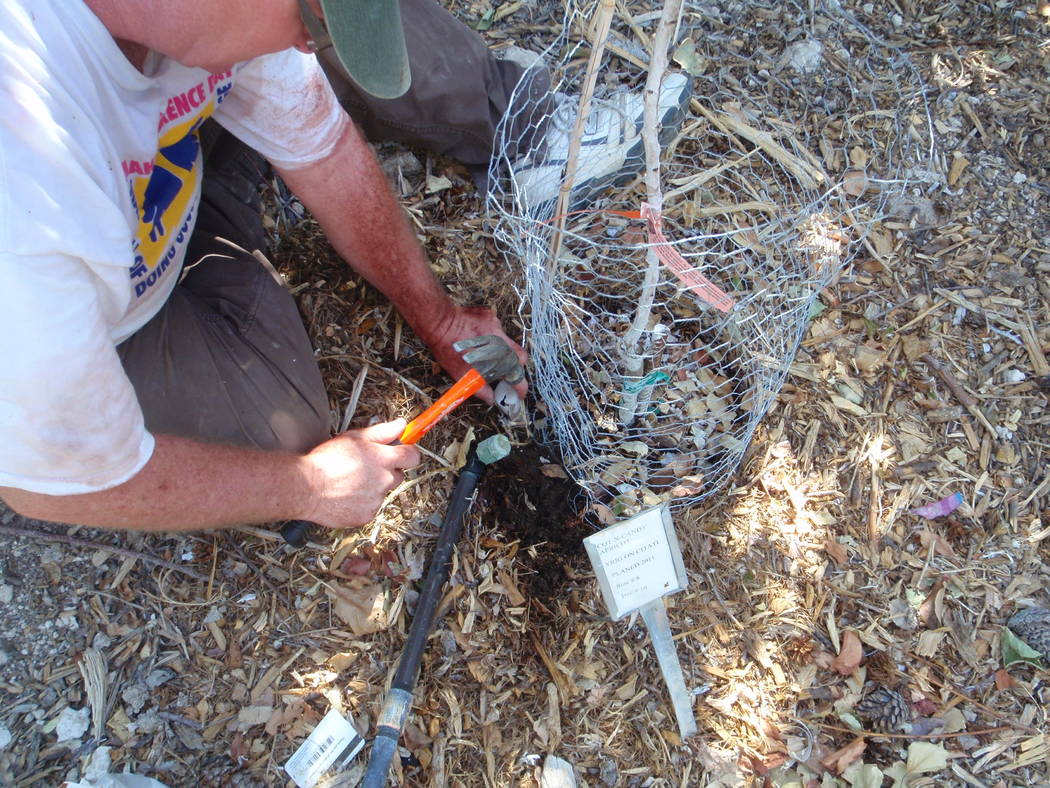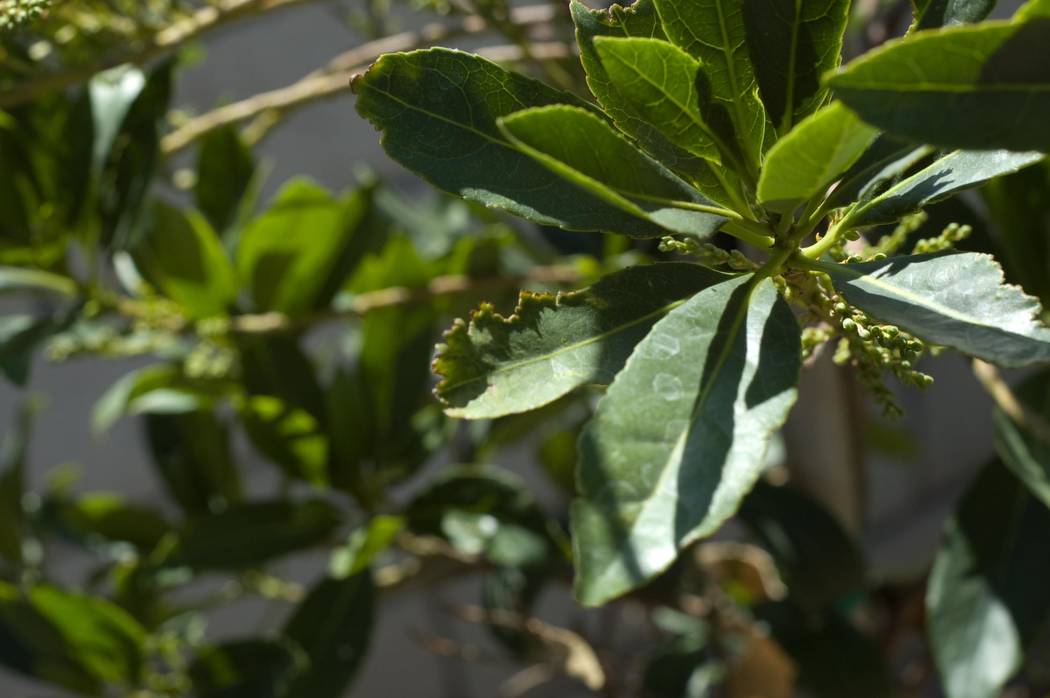Citrus trees need to be protected from winter temperatures


I will be at the Home Improvement and Backyard Expo at the South Point on Sept. 16 and 17, from 11 a.m. until 2 p.m. I will be there to answer any questions you may have and to chat. I will stay longer if people have questions. Come and see me. I would love to talk with you.
Q: Why don’t you have different types of citrus on your recommended fruit tree list? I know you mentioned that Las Vegas isn’t citrus country, but if I protect them from the winter winds and gave them some frost protection would lemons and oranges have a chance?
A: I don’t recommend planting citrus in the Las Vegas Valley as a rule. There are people who have successfully grown citrus here for decades, people who have lost them to winter cold and others who experience winter damage to them but the tree survives. I don’t want to recommend planting fruit trees here that aren’t a sure thing. Just understand you take a risk when you plant them.
The most damaging winter weather to citrus is cold winds combined with low temperatures. If you can find a spot in your landscape that provides protection from these two elements, i.e., a warm microclimate, citrus has a chance of surviving and possibly producing fruit.
The other option is to do as you suggest, protect them from winter cold temperatures and nasty winds. They don’t need to be protected 24 hours a day when temperatures are threatening. They need to be protected only when the temperatures drop below freezing. As soon as temperatures are past the danger zone, remove the protection.
Backyards have very strange wind patterns. Often winds are stronger along the sides of homes where these spaces increase wind speeds and in some parts of the yard. Watch and think about how winds move through your property and select the best location possible. Otherwise, construct mini windbreaks out of chain-link fence and PVC slats. It is better to slow the wind rather than to block it.
Citrus trees resist death by freezing as they get older. The tree may not freeze but there is still a possibility that your crop of fruit can be good one year and bad the next depending on the weather. As these trees get larger, they’re more difficult to protect from freezing temperatures and wind.
Depending on the type of citrus, some survive temperatures as low as the mid-20s. The University of Arizona published a list of recommended varieties on the Internet that also perform well here if grown in the right microclimate. Google “Arizona recommended citrus varieties,” or send me an email and I will forward the link to you, or contact the Master Gardener Help Desk at 702-257-5556 and they will mail a copy to you.
The climate of the Las Vegas Valley is too cold during the winter to support a general recommendation to grow citrus here. However, there are nooks and crannies in people’s backyards that can grow some of the more tender citrus to winter freezing temperatures. Be smart and think about these locations before you plant.
Q: I was wondering when you like to fertilize fruit trees.
A: Let’s separate temperate fruit trees from the winter-tender, semi-tropical fruit trees on the topic of fertilizing. The easiest way to think about this is to put all citrus into the semi-tropical category.
The other fruit trees that grow in the Mojave Desert without winter protection are temperate fruit trees. Temperate fruit trees such as apples, peaches and plums are easiest to grow in climates where there are strong four seasons of weather.
Temperate fruit trees begin flowering after cold winter temperatures have passed. Cold winter temperature is one of the plant triggers that initiates flowering in temperate fruit trees. Another major trigger is the shortening of nighttime.
Semi-tropical fruit trees, depending on the species, flower at various times during the year. They respond to other triggers for flowering since most originated in the subtropics.
In climates like ours where there is a potential threat from damaging winter temperatures, do not fertilize any semi-tropical, winter-tender plants after Aug. 1. Applying nitrogen fertilizers after this date causes the tree to have less tolerance to cold winter temperatures.
All fruit trees respond nicely to one fertilizer application for the entire year unless they are growing in very sandy soils. If fruit trees are growing in these soils, divide this single application into three to four applications, two to three months apart. But one of these applications should be at the beginning of the growing season and another soon after harvest.
Probably the most important time for a fertilizer application for temperate fruit trees is just before flowering in the spring; late January in our climate. This is also the best time to apply iron fertilizers to the soil if needed.
Probably the second most important time is just after harvest to replenish the nutrients taken from the tree. You can split the total application of fertilizer into two smaller applications if you want to; one in early spring, as before, and the second half just after harvest.
Let the tree tell you if it needs fertilizer or not. How? Look at the past season’s growth. If it was very strong, you might skip a fertilizer application that year. If it was weak, you might increase the amount applied. Ideally, 18 to 24 inches of new growth, as an average, is a good amount.
Q: I have a lot of small black beetles coming out at night eating the leaves of my roses. They are not Japanese or squash bugs. They are ⅓ inch in size and all black.
A: The size you are describing fits the root weevil adult exactly but they normally feed only on the edges of the leaves. The only way to know if you have this insect feeding on your plants is to inspect the leaves at night with a flashlight.
These are ¼- to ½-inch-long brown or black weevils. If you look closely at them, you should see lines or striations running lengthwise down their wing coverings. There are different kinds; some of them have a snout for a mouth and others do not.
They live mostly in the upper surface of the soil or in litter around the base of the plants. They climb up the plants at night to feed and go back into the soil before daylight.
If this is a root weevil problem, there are several approaches toward controlling them. The first is reducing their numbers by picking them off leaves at night. When you see the damage to the leaves, go out at night with a flashlight, look for them and dispose of them in a cup of full-strength vinegar. It will take several trips to these plants at night but well worth it.
You can trap them and then remove them by laying corrugated cardboard on the surface of the soil beneath the plants or tying a 3- to 4-inch cylinder around the plant trunks.
You can create barriers but this doesn’t reduce their numbers. A 3-inch-wide barrier can be made of commercial products such as Tanglefoot or axle grease. You can create a similar barrier, supposedly, by spraying the leaves with neem oil or by trying some other oils such as rosemary. I have no experience with this so this advice is anecdotal.
Beneficial nematodes applied to the soil in a water slurry are supposed to work. It’s worth a shot and won’t hurt anything.
Pesticides such as pyrethrins or synthetic pyrethroids sprayed on the leaves will reduce their numbers. Soap and water sprays only work if sprayed directly on the root weevil.
Bob Morris is a horticulture expert and professor emeritus of the University of Nevada, Las Vegas. Visit his blog at xtremehorticulture.blogspot.com. Send questions to Extremehort@aol.com.













